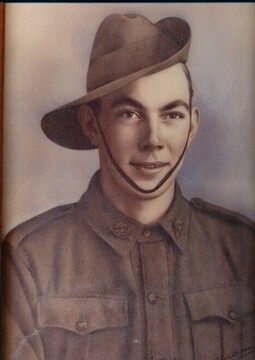
SALIXS, Alfred Joseph
| Service Number: | VX50490 |
|---|---|
| Enlisted: | 6 March 1941 |
| Last Rank: | Private |
| Last Unit: | 2nd/24th Infantry Battalion |
| Born: | KOONDROOK, VIC, 8 July 1920 |
| Home Town: | Not yet discovered |
| Schooling: | Not yet discovered |
| Occupation: | Not yet discovered |
| Died: | Accidental (Drowning), At sea (Middle East), 21 October 1941, aged 21 years |
| Cemetery: | Not yet discovered |
| Memorials: | Alamein Memorial, Australian War Memorial Roll of Honour, Barham War Memorial, Wangaratta 2/24th Infantry Battalion Memorial Wall |
World War 2 Service
| 3 Sep 1939: | Involvement Private, VX50490 | |
|---|---|---|
| 6 Mar 1941: | Enlisted Australian Military Forces (WW2) , Private, VX50490, 2nd/24th Infantry Battalion |
Help us honour Alfred Joseph Salixs's service by contributing information, stories, and images so that they can be preserved for future generations.
Add my storyBiography contributed by Norman John McMurtrie
THE UNLUCKY HERO AWARD and a twist to the tale
Alfred Joseph Salixs
Alfred’s Battalion, the 2/24th was attached to the 9th Australian Division, one of the most famous army fighting formations in World War 2. During the Tobruk siege they were called The Rats of Tobruk by Lord Haw Haw (William Joyce), the German propagandist. In early 1941 the 2/24th moved to Tocra in Cyrenaica (Libya) to complete its training and to relieve the 6th Division. Told by General Wavell to hold Tobruk for 2 months, the 2/24th held Tobruk for the eight months from 10 April until 20 October. Leaving behind the 2/13th, the 9th Division was evacuated by sea over a period of a month.
The 2/24th left on the night of 20 October, by the “Tobruk Ferry Service” sailing to Alexandria and then on to Palestine and Syria for rest, reinforcement and garrison duties after eight months of intense warfare without break.
Alfred’s “C” Company was assigned to board the HMS Gnat (T60) Insect Class Gunboat. At 4.45 a.m. on the 21st HMS Gnat was torpedoed about 60 miles east of Tobruk by the German submarine U79. Her bows were blown off but she did not sink. The nightly relief convoy was at that time to the east of the Gnat, making good speed for Alexandria.
Four destroyers, including HMAS Nizam, went to Gnat's assistance but not long afterwards the Commander-in-Chief ordered them to turn eastward because of threatened air attack. When the Nizam, which had part of the 2/24th Battalion aboard, turned in compliance with this order, a huge wave broke over the ship and swept 21 men of the battalion overboard. The Nizam turned again and went to their rescue; sailors dived overboard and helped to sustain them; but Alfred and five other men were drowned and two seriously injured, one mortally.
In November 1944, the destroyer sailed to Melbourne for another refit. In a tragedy which harked back to that of 21st October 1941, on 11th February 1945, while crossing the Great Australian Bight in poor weather after the refit, Nizam was hit by a freak wave which caused the ship to roll almost eighty degrees to port, and washed ten sailors overboard, none of whom were ever seen again.









